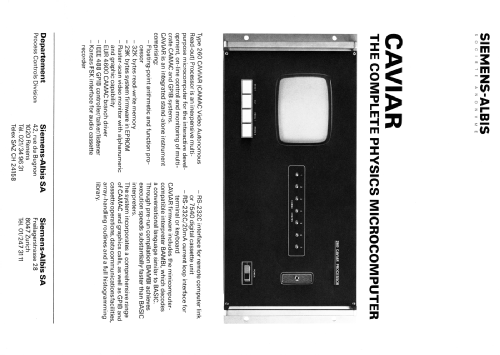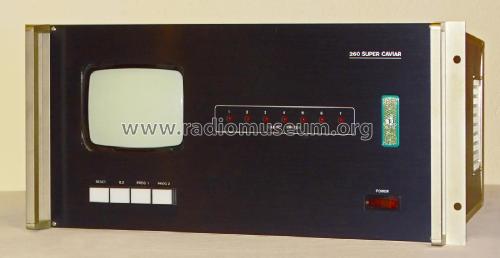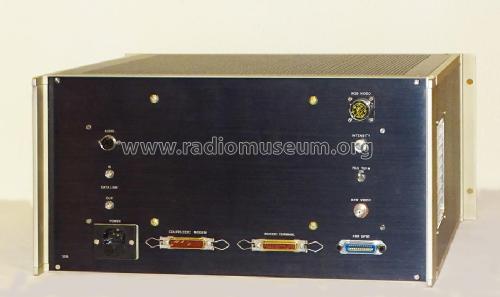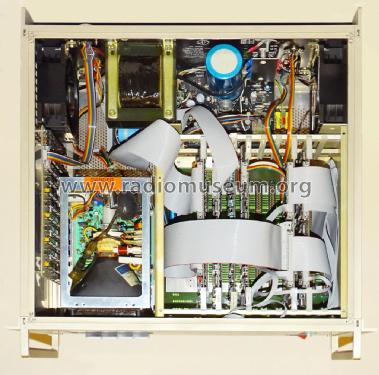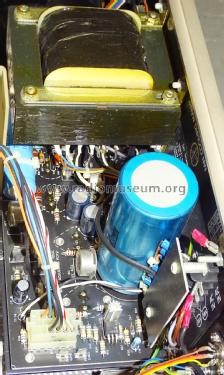CAVIAR Microcomputer 260
Albis, Albiswerke AG (Siemens Switzerland AG / Telefunken Zürich AG / Siemens-Albis); Albisrieden
- Hersteller / Marke
- Albis, Albiswerke AG (Siemens Switzerland AG / Telefunken Zürich AG / Siemens-Albis); Albisrieden
- Jahr
- 1978–1985
- Kategorie
- Signal Processing and Computing
- Radiomuseum.org ID
- 305149
Klicken Sie auf den Schaltplanausschnitt, um diesen kostenlos als Dokument anzufordern.
- Anzahl Röhren
- 1
- Röhren
- Anzahl Transistoren
- Halbleiter vorhanden.
- Halbleiter
- Wellenbereiche
- - ohne
- Betriebsart / Volt
- Wechselstromspeisung / 220-250 Volt
- Lautsprecher
- - Dieses Modell benötigt externe(n) Lautsprecher.
- Material
- Metallausführung
- von Radiomuseum.org
- Modell: CAVIAR Microcomputer 260 - Albis, Albiswerke AG Siemens
- Form
- Rack
- Abmessungen (BHT)
- 484 x 222 x 498 mm / 19.1 x 8.7 x 19.6 inch
- Bemerkung
-
CAVIAR (CAMAC Video Autonomous Readout) was an early microcomputer designed in 1977 for the data acquisition, control and monitoring of multi-crate ESONE CAMAC and IEEE-488 GPIB systems. CAVIAR incorporates an EUR4600e branch driver for communication with Type A1/A2 crate controllers in up to 7 CAMAC crates, each of which can contain up to 23 modules. It also has two RS232C serial ports for a terminal and modem, or a 7540 digital cassette unit, and a GPIB controller for connection to up to 15 other instruments, including an external dual floppy disc drive and printer. It has a small integrated CRT monitor and provides a European-standard composite video output for driving larger external displays, an optional AFSK interface for recording programmes on audio cassette, and a Motorola Advanced Data Link Controller (ADLC) for remote readout processors.
The CAVIAR CPU/FPU is a Motorola 6800 microprocessor coupled with an AMD 9511 floating-point arithmetic and function processor. Floating-point execution times range from 30 microseconds minimum for an add to 93 microseconds for divide, while 11 derived floating-point functions execute in times from 434 microseconds for square root to 5 ms for exponentiation. Trigonometric functions typically execute in 2 - 4 ms, and the speed of evaluation of logarithms permits the semi-log and log-log scaling of graphics.
As higher density EPROM and RAM chips became available, CAVIAR was continually upgraded, adding multi-page colour graphics and alphanumerics as well as larger memory and features such as programmable audio output. To overcome the 64 KB address limitation of the 6800 microprocessor, a SuperCAVIAR converter was developed that used memory mapping to expand the physical address space to 344 KB. This facility provided independent firmware and RAM maps, dynamic allocation of common RAM, automatic inter-page transfer modes, and a RAM/EPROM overlay. After VME systems became popular, a coprocessor interface was developed to allow CAVIAR to interact with VMEbus modules.
The CAVIAR card cage has 9 slots and uses the Motorola micromodule bus with memory-mapping enhancements. 11 EPROMs can be accommodated on the mapper card itself to store a resident editor and Basic-like interpreter that was written in assembler and achieves high speed by pre-run compilation. The interpreter has an extensive library including subroutines for extended array-handling and graphics, including histogramming, isoline plotting, line-fitting and FFT operations. The process of firmware mapping is transparent to the user, who simply finds that there is a greater number of calls at his disposition.
When 64K dynamic RAM chips became available in 1980, a 256 KB RAM/programmable timer card was designed that mapped into 8 areas of 32 KB. For interrupt vectors and pointers for inter-RAM communication, a programmable range of RAM at the base of each map is common to all of them. Programs and data can be readily interchanged between different RAM maps, and programs resident in more than one map can be executed with no limit on the jumps between maps.
Initially CAVIAR had a linear power supply, but this was later upgraded to a more efficient switcher that allowed quieter fans to be fitted. As it was most used in a research/industrial environment it was normally supplied in a rack-mounted case which could be converted for bench-top use in the field if required.
CAVIAR was designed by Bruce Taylor in 1977 and, following competitive bidding by 8 European companies, it was manufactured by Siemens-Albis SA from 1978 till 1985, when it was obsoleted by further progress in microprocessor and RAM technology. CAVIAR microcomputers were used for a wide range of tasks by research and industrial organisations in many countries, and some of them were still in service in the 1990s.
- Nettogewicht
- 17.3 kg / 38 lb 1.7 oz (38.106 lb)
- Literaturnachweis
- - - Manufacturers Literature
- Autor
- Modellseite von Bruce Taylor angelegt. Siehe bei "Änderungsvorschlag" für weitere Mitarbeit.
- Weitere Modelle
-
Hier finden Sie 176 Modelle, davon 152 mit Bildern und 146 mit Schaltbildern.
Alle gelisteten Radios usw. von Albis, Albiswerke AG (Siemens Switzerland AG / Telefunken Zürich AG / Siemens-Albis); Albisrieden
Sammlungen
Das Modell CAVIAR Microcomputer befindet sich in den Sammlungen folgender Mitglieder.


